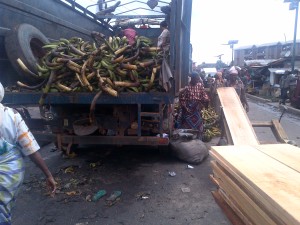Ọ̀gẹ̀dẹ̀ jẹ́ èso ti ó wọ́pọ̀ lára àwọn ohun ọgbin ti a lè ri ni ilẹ̀ Yorùbá pàtàki ni agbègbè Okitipupa ni ipinlẹ Ondo. Ọ̀gẹ̀dẹ̀ pé oriṣiriṣi, ọ̀gẹ̀dẹ̀ àgbagbà ni à nsè fun jijẹ, nigbati ọ̀gẹ̀dẹ̀ wẹ́wẹ́ dára fún jijẹ bi èso lai sè. Ọ̀gẹ̀dẹ̀ àgbagbà tóbi ju ọ̀gẹ̀dẹ̀ wẹ́wẹ́ lọ.
Ni ayé àtijọ́, ohun ọgbin ti ó bá pọ̀ ni agbègbè ni èniyàn ma njẹ, nitori ko si ọkọ̀ tàbi ohun irinna tó yá lati kó irè oko kan lọ si ekeji. Eleyi jẹ ki àwọn ti iṣu pọ ni ọ̀dọ̀ wọn lo iṣu lati ṣe oúnjẹ ni oriṣiriṣi ọ̀nà, àwọn ti o ni àgbàdo pupọ nlo fún onírúurú oúnjẹ ti a lè fi àgbàdo ṣe, àwọn ti ó ni ẹ̀gẹ́/gbaguda ma nlo lati ṣe oriṣiriṣi oúnjẹ àti bẹ́ẹ̀-bẹ́ẹ̀ lọ.
- Oko Iṣu – Yam farm
- Ìsọ̀ iṣu – Yam stalls at Mushin, Lagos. Courtesy: theyorubablog
- Igi Ọ̀gẹ̀dẹ̀ – Plantain Tree
- Igi Ọ̀gẹ̀dẹ̀ wẹ́wẹ́ – Banana Trees
Ìyàtọ laarin iṣu ati ọ̀gẹ̀dẹ̀ ni pé, wọn wa iṣu ninú ebè nigbati wọn nbẹ́ ọ̀gẹ̀dẹ̀ lóri igi rẹ. Kò si iyàtọ̀ laarin Èlùbọ́ iṣu àti Èlùbọ́ ọ̀gẹ̀dẹ̀, ṣugbon bi a bá ro fun àmàlà, àmàlà iṣu dúdú díẹ ju èlùbọ́ ọ̀gẹ̀dẹ̀ gbigbẹ, àmàlà, ọ̀gẹ̀dẹ̀ tútù kò dúdú ó pọ́n fẹ́rẹ́fẹ́. Iṣu tútù kò ṣe e bùṣán nitori yio yún èniyàn ni ọ̀fun, nibi ti ó burú dé, bi omi ti wọn fi fọ iṣu bá ta si ni lára, yio fa ara yin yún. Gẹ́gẹ́ bi òwe Yorùbá ti ó ni “Ọ̀gẹ̀dẹ̀ dúdú/burúkú kò yá bù ṣán, ọmọ burúkú kò yá lù pa”, ọ̀gẹ̀dẹ̀ dúdú kò dùn lati jẹ ni tútù, eyi ti ó bá ti kẹ̀ naa kò ṣe é jẹ, ṣùgbọ́n ọ̀gẹ̀dẹ̀ ti ó pọ́n ṣe jẹ ni pi pọ́n lai sè nitori adùn rẹ. Àti ewé àti èso ọ̀gẹ̀dẹ̀ ni ó wúlò fún jijẹ.
ENGLISH TRANSLATION
Plantain also known as Banana is a common fruit among other farm produce in Yoruba land, particularly in Okitipupa in Ondo State. There are various types of Plantain/Banana, plantain is cooked in various form of meals while banana is often eaten as fruit without cooking. Plantains are bigger in size than most bananas.
In the olden days, people relied on local agricultural produce for their source of food, because of little or no transportation to move the agricultural products from one community to another. This made people look inward, by consuming in various form, the farm produce peculiar with their area. Those producing yam use it to prepare various meals, those who produce corn/maize in abundance use it for various corn meals, while the communities that produce cassava use it for various cassava meals etc.
The difference between yam and plantain is, yam is harvested by digging it out from the heap of soil it was planted, while plantain are cut down from its tree. There is little or no difference between Yam flour and plantain flour, but when both are prepared as solid meal, yam meal is a bit darker than dry plantain meal but raw plantain meal is lighter. Raw yam cannot be snacked on because it causes itchy throat while the water used in washing raw yam, causes serious itching if it touches the skin. According to Yoruba proverb “Unripe/rotten plantain is no easy snack, beating a bad behaved child to death is not an option”, unripe plantain is not sweet eaten raw, the rotten one too cannot be eaten, but a ripe plantain can be eaten raw because of its sweetness. Everything about Plantain or Banana are useful, both the leaves and the fruits are edible.
Originally posted 2014-12-02 19:09:48. Republished by Blog Post Promoter








